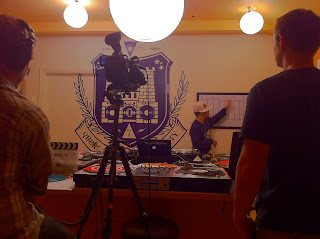What Is Skratch Theory?

We recently went down to the QSU HQ to film a new series of lessons. It had been over two years since the original Lessons for QSU were filmed, and Q wanted to expand the curriculum to address many of the recurring themes he'd been teaching in the video exchanges (aka Master Classes) - a new section that we're calling Skratch Theory.
Qbert and D-Styles @ Low End Theory
It was Thursday and it'd been a busy week around the office. I was in the middle of editing the footage from Q's last show when I looked at my phone. I had a text message. It was Ted from Thud Rumble.
"Are you pumped for tomorrow night??"
Was I pumped? I couldn't sleep. When I did sleep, I had strange dreams of skratching.
Why Does Qbert Scratch Reverse?
I’m often asked by students: why does Qbert scratch in reverse? What they mean is, why is the crossfader in the reverse setting (aka hamster style). Before I get into that, let me break down a few things. Traditionally, DJs use two turntables with a mixer in the middle. The crossfader on the mixer cuts the sound in and out from the right and left turntable by sliding the fader to the right or left. Scratching (or ‘skratching’ as we like to say at QSU) is the manipulation of a sound on a turntable, pushing the record back and forth in a percussive way to create a new sound. The crossfader is used to cut the sound in and out while manipulating the record, and there’s a whole vocabulary and language for the different scratches and combos (for those interested in learning to speak the skratch language, join QSU!).
In the ‘regular’ setting, when the crossfader is on the left you hear what’s playing on the left turntable. When the crossfader’s on the right, you hear the right turntable. When it’s in the middle, you hear both turntables. Simply put, left=left and right=right. On the reverse setting, it’s the exact opposite (left=right and right=left).







